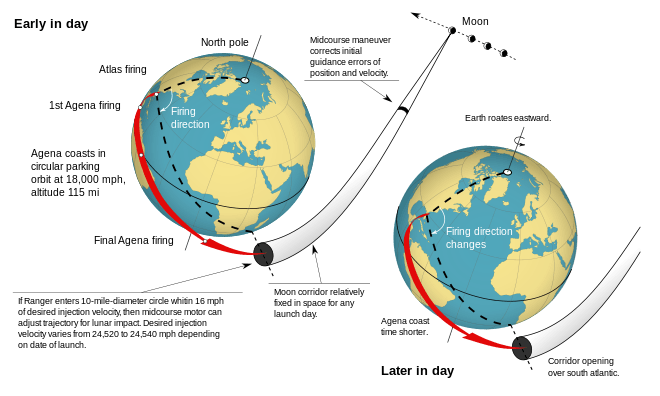Parking orbit
A parking orbit is a temporary orbit used during the launch of a satellite or other space probe. A launch vehicle boosts into the parking orbit, then coasts for a while, then fires again to enter the final desired trajectory. The alternative to a parking orbit is direct injection, where the rocket fires continuously (except during staging) until its fuel is exhausted, ending with the payload on the final trajectory.

Rationale for parking orbits
There are several reasons why a parking orbit may be used:
- It can increase the launch window. For earth-escape missions, these are often quite short (seconds to minutes) if no parking orbit is used. With a parking orbit, these can often be increased up to several hours.[1][2]
- For non-Low Earth orbit missions, the desired location for the final burn may not be in a convenient spot. In particular, for earth-escape missions that want good northern coverage of the trajectory, the correct place for the final burn is often in the southern hemisphere.
- For geostationary orbit missions, the correct spot for the final (or next to final) firing is normally on the equator. In such a case, the rocket is launched, coasts in a parking orbit until it is over the equator, then fires again into a geostationary transfer orbit.[3]
- For manned lunar missions, a parking orbit allowed some checkout while still close to home, before committing to the lunar trip.[2]
- It is needed if the desired orbit has a high perigee. In this case the booster launches into an elliptical parking orbit, then coasts until a higher point in the orbit, then fires again to raise the perigee. See Hohmann transfer orbit. In this case the use of a parking orbit can also reduce the fuel usage of an inclination change, since these take less delta-V at high elevations.
The figure shows the first two reasons. For this lunar mission, the desired location for the final firing is originally over southern Africa. As the day progresses, this point stays essentially fixed while the Earth moves underneath, and this is compensated for by changing the launch angle.
Disadvantages of parking orbits
The most notable disadvantage is that a rocket needs to coast for a while, then restart while under zero g conditions. Furthermore the length of two of the burns (the initial injection burn, and the final burn) typically depend on where in the launch window the launch occurs. To do this without wasting fuel, a rocket stage that can fire, then stop, then start again is needed. This implies a liquid fuel engine since solid fuel rockets cannot be stopped or restarted - once ignited they burn to completion. But even in a liquid-fueled engine, this multiple restart capability is non-trivial for a number of reasons:
- During the coast, the propellants will drift away from the bottom of the tank and the pump inlets. This must be dealt with in some way.[4] Common methods are tanks with diaphragms, or ullage rockets for settling the propellant back to the bottom of the tank.
- Longer life batteries and other consumables are needed.
- Some engines use special chemicals for ignition; multiple sets are needed for restarts
- Better insulation is needed, particularly on cryogenic tanks, to prevent too much propellant boiloff during coast.
- A better inertial guidance system is needed, to keep track of the state during the coast.
- A reaction control system is needed, to orient the stage properly for the final burn, and perhaps to establish a suitable thermal orientation during coast.
The Centaur and Agena families of upper stages were designed for such restarts and have often been used in this manner. The last Agena flew in 1987 but Centaur is still in production. The Briz-M stage often performs the same role for Russian rockets.
Examples
- The Apollo program used parking orbits, for all the reasons mentioned above except those that pertain to geostationary orbits.[5][6]
- When the shuttle launched interplanetary probes such as Galileo, it used a parking orbit to deliver the probe to the right injection spot.
- The Ariane 5 does not use parking orbits. This simplifies the launcher since multiple restart is not needed, and the penalty is small for their typical GTO mission, as their launch site is close to the equator. An upgrade to the second stage (ESC-B) will have multiple restart capability, so future missions may use parking orbits.
- In a literal example of a parking orbit, the Automated Transfer Vehicle (ATV) can park for several months in orbit while waiting to rendezvous with the International Space Station. For safety reasons, the ATV cannot approach the station while a Space Shuttle is docked or when a Soyuz or Progress are maneuvering to dock or depart.[7]
References
- ↑ Hall, R. Cargill (1977). LUNAR IMPACT - A History of Project Ranger. NASA History Series (Technical report) (National Aeronautics and Space Administration). NASA SP-4210. Retrieved 2011-11-11.
- ↑ 2.0 2.1 "Apollo Expeditions to the Moon". Chapter 3.4
- ↑ Charles D. Brown. Spacecraft Mission Design., page 83.
- ↑ Krivetsky, A.; Bauer, W.H.; Loucks, H.L.; Padlog, J. & Robinson, J.V. (1962). Research on Zero-Gravity Expulsion Techniques (Technical report). Defense Technical Information Center.
- ↑ "Apollo lunar landing launch window: The controlling factors and constraints". NASA.
- ↑ "Apollo Flight Journal - Apollo 8, Day 1: Earth Orbit and Translunar Injection". NASA.
- ↑ Stephen Clark. "Maiden launch of Europe's resupply ship gets new date". Spaceflight Now.
| ||||||||||||||||||||||||||||||||||||||||||||||||||||||||||||||||
















